Achillea, Yarrow
Milfoil, MillefoliumBrinjasif, Biranjaasif (Unani)
Al-Biranjaasf (Arabic)
Yang Shi Cao (TCM)
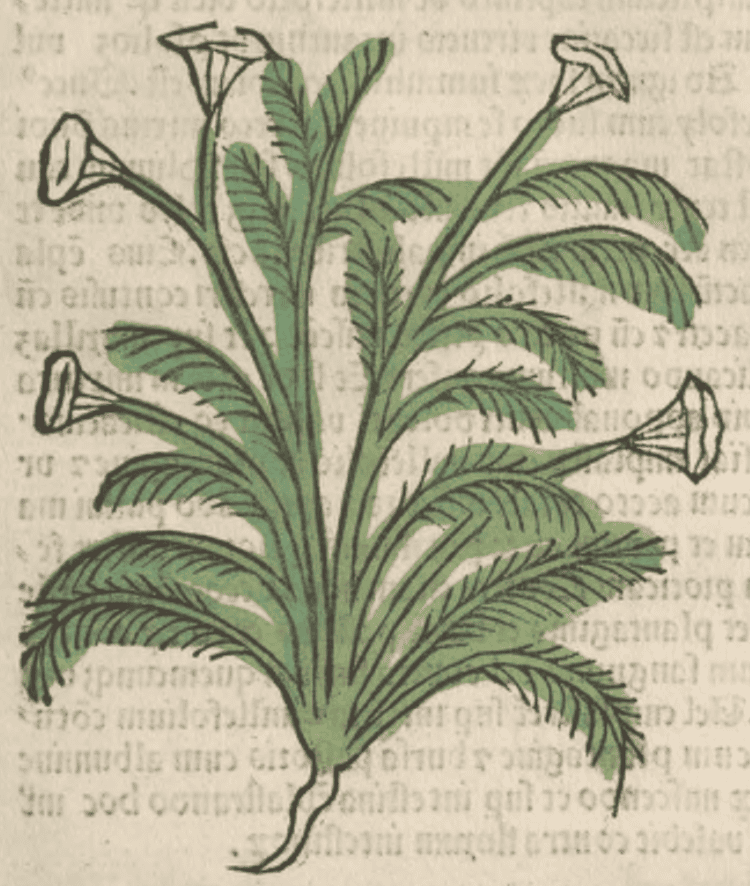 Herbarius latinus, Petri, 1485
Herbarius latinus, Petri, 1485 |
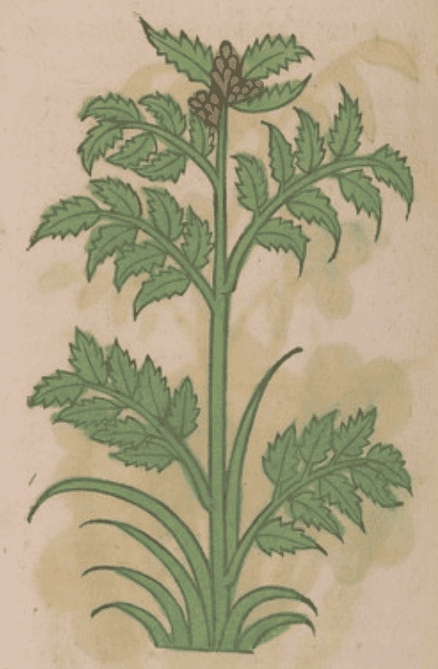 Ortus Sanitatis, Meydenbach, 1491
Ortus Sanitatis, Meydenbach, 1491 |
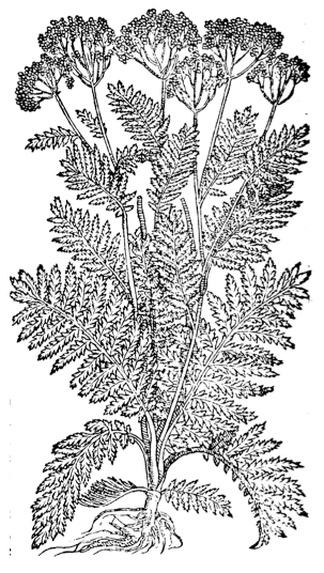
|
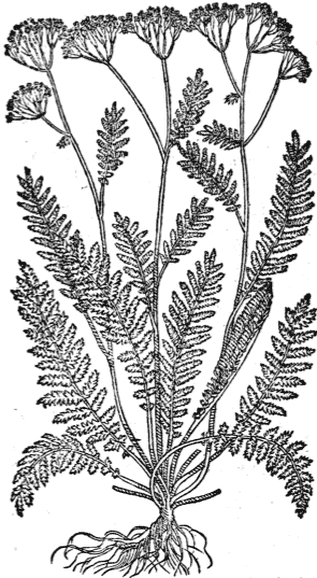
|
Della Materia Medicinale, Valuassori, 1562
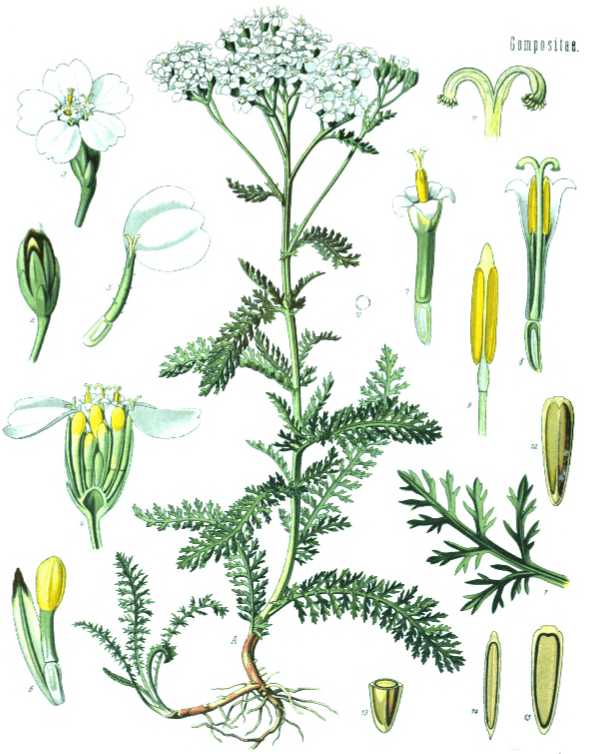 Koehler’s Medizinal Pflanzen, 1887
Koehler’s Medizinal Pflanzen, 1887Botanical name:
Achillea millefolium
Parts used:
Herb in flower
Temperature & Taste:
Cool (some said Warm), dry. Bitter
“Cold and Moist in the First degree”. (Avicenna)
Classification:
2O. ASTRINGENTS. 2P. HEMOSTATICS. 2T. GLUTINATE
3A. SUDORIFICS & DIAPHORETICS
Uses:
1. Clears Wind-Heat, Resists Poison, Promotes Sweat:
-Fevers including Spotted and Intermittent; Fever with Chills; Typhoid Fever, Malaria
-promotes rashes in Measles, Small Pox, Chicken Pox
-Pleurisy, Pneumonia, Tuberculosis (auxiliary herb for these conditions)
–’some hold the Herb and the Flower for the great secret to preserve from, and cure the Plague’. (Schroder)
2. Moves the Blood, Clears Stasis, Regulates Menstruation:
-painful and irregular Menstruation; Dysmenorrhea, Amenorrhea, Menorrhagia
-Menopausal disorders
-Wounds, Bruising, internal Injury
-Cerebral and Coronary Thrombosis
-prevents Thrombosis after stroke, heart attack or surgery
-Tumors and Cancers (Breast, Liver, Spleen, Genitals etc.)
-recommended before and after Cancer surgery to prevent Metastases
-“It is useful in Ulcers, expels Fetus and Placenta, opens the mouth of Uterus (Os Uteri) and removes its hardness when administered orally or applied in the form of a plaster”. (Avicenna)
3. Stops Leakage and Bleeding
-Diarrhea, Dysentery, Gonorrhea, Spermatorrhea, Leukorrhea
-stops Bleeding, good for Hemorrhage from the Nose, Bowels, Uterine Bleeding, Spitting of Blood etc.
–Menorrhagia (‘one of the best remedies’, King’s)
-Incontinence
-Diabetes, Brights disease (various incl. King’s)
-“It dissolves Kidney Stones”. (Avicenna)
4. Calms the Mind, Settles Wind, Stops Spasms:
–Headache, Migraine, Nervousness, Hysteria, Melancholy, Epilepsy, Cramps, Depression
-more recently for Hypertension
5. Benefits the Stomach:
–poor Appetite, stomach Cramps, Flatulence, Dyspepsia, Gastritis
6. Kills Worms.
7. Externally:
-Wounds, Tumors and Inflammations
-externally for Headaches, sore Eyes, blood nose, bleeding Wounds, Toothache
-topically to Hemorrhoids, Hernias, Hematomas
-in douches or to the lower abdomen for excess Menstruation, Leukorrhea; also in douches to tighten the Vagina
-“Sitting in its decoction helps in (regulating) menstruation”. (Avicenna)
-applied to venomous Bites, Tumors,
-mouth wash for Mouth Sores and Ulcers, rotten Gums etc.
-juice is applied to Warts
-hair wash for Dandruff
-“Inhalation of the vapours arising from its decoction gives relief in cases of Nasal Obstruction”. (Avicenna)
-in Baths for Rheumatism, Nervous disorders
Dose:
Infusion or Brief Decoction: 3–9 grams (up to 15 grains)
Powder: 1–3 grams
Used in Enemas, Douches, Baths, Washes, Plasters etc.
Corrective:
Aniseed
Substitute:
1. Camomile
2. Mugwort (Unani)
3. “It is a herb resembling Wormwood”. (Avicenna)
Main Combinations:
Burdock root & Yarrow
ACUTE DISEASES, FEVER, COUGH:
1. Cold or Flu:
i. from Wind-Heat, Yarrow with Elder flower, Peppermint
ii. with Cough, Yarrow with Thyme, Licorice
iii. with Sore Throat, Headache, Yarrow with Sage, Peppermint, Licorice
2. Cold, Flu with Sinus congestion:
i. Yarrow with Angelica
ii. Yarrow with Angelica, Elder flower, Eyebright
3. To promote Expression of Measles, Yarrow with Burdock root, Peppermint
4. Cough, Bronchitis:
i. Yarrow with Elecampane and Mullein
ii. Pectoral Lohoch: Yarrow, Ground Ivy (2 ½ oz. each), Hyssop, Bittersweet (1 oz. each), boiling water (3 pounds); Infuse 12 hours, then boil gently to half; express strongly, then add Honey (3 pounds) and Vinegar (1 pound), boil over a gentle fire to the consistency of Honey. (Dispensatorium Pharmaceuticum, 1777)
5. Recurring Fever, Yarrow with Wormwood, Gentian, Barberry, Licorice
6. Acute Inflammation, Yarrow with Peppermint and Elder flower
MIND, NERVES:
7. Anxiety and Nervousness related to Menstruation, Yarrow with Balm, Valerian
8. Depression related to Menstruation, Yarrow with Balm and St. Johns wort
GYNECOLOGY:
9. Amenorrhea:
i. Yarrow with Mugwort, Rue, Angelica
ii. Yarrow with Mugwort, Motherwort, Wild Thyme (Pharmacopee Usuelle, Louvain, 1821)
10. Menstrual pain:
i. Yarrow with Valerian and Hops
ii. Yarrow with Alder Buckthorn bark, Senna, Couch grass
11. Menstrual disorders, Yarrow, Camomile, Balm
12. Excessive Menstruation, Yarrow with Shepherd’s Purse, and Tormentil (Kroeber)
13. Pelvic Inflammation, Yarrow with Sage and Calendula
14. Leukorrhea, Yarrow with Archangel, Hounds Tongue and Red Sandalwood
GASTROINTESTINAL:
15. Stomach diseases:
i. Yarrow with Centaury
ii. Yarrow with Camomile, Peppermint
16. Gastritis, Yarrow with Wormwood, Gentian, Licorice
CIRCULATION, BLEEDING:
17. Hypertension:
i. Yarrow with Balm and Peppermint
ii. Yarrow with Mistletoe and Hawthorn
18. Bleeding:
i. Yarrow with Comfrey
ii. Yarrow with Plantain, Shepherd’s Purse
iii. Hemoptysis, Yarrow with Comfrey and Plantain
iv. Hemoptysis, Yarrow with Tormentil, Pimpinella saxifraga, Plantain, Golden Rod, Rose (equal parts). (Dispensatorium medico pharmaceuticum Palatinatus, 1764)
v. Hemostatic Powder: Fox Tail grass, Yarrow, Plantain leaf, Knotgrass leaf, Nettle leaf (1 handful each), water (3 pounds), boil to two-thirds (Memorial Pharmaceutique, 1824)
19. Hemorrhoids:
i. Yarrow, Plantain, Comfrey, topically
ii. Yarrow, Camomile, Calendula
iii. Yarrow with Pilewort, Cranesbill and Mullein as an infusion internally and topically.
20. Varicose veins, Yarrow with St. Johns wort and Arnica flower (or Calendula) internally and topically.
21. Coronary Thrombosis, with Nettle and Calendula
OTHER:
22. Astringent Powder: Yarrow with Tormential, Pimpinella Saxifrage, Plantain, Golden Rod, Rose (Dispensatorium medico pharmaceuticum Palatinatus, 1764)
23. Stones, Betony, Vervain, Yarrow (Pliny)
24. Vulnerary (for Wounds and Trauma):
i. Yarrow with Betony, Plantain, Sanicle, Mullein, Periwinkle, Pimpinella saxifraga, Oak leaf
ii. Yarrow with Betony, Marjoram, Vervain, Sanicle, Houseleek
Cautions:
1. Caution during Pregnancy, avoid full doses.
2. Large doses may cause Headache and Vertigo
Main Preparations used:
Juice, Syrup, Tincture, Distilled Water, Extract
1. Juice of Yarrow:
i. Take fresh yarrow, beat in a stone mortar, sprinkling with a little water; express strongly, set aside, decant, and preserve in bottles (usually with a layer of oil on top). (Dispensarium electorale Hassiacum, 1806)
2. Syrup of Yarrow:
i. Fresh Yarrow leaf (1 ½ pounds), Boiling Water (3 pounds). Infuse 12 hours, filter, and add White Sugar (twice its weight). Dose: ½–2 oz. (Pharmacopoeia Gallica, 1818)
3. Tincture of Yarrow:
Principally used for Piles, Menorrhagia, Nephritic pain. Dose: 50–70 drops.
i. Yarrow (3 oz.), Alcohol (16 oz.). Digest 3 days, express, and add Yarrow (2 oz.). Digest 3 more days, express, filter. (Dispensatorium medico pharmaceuticum Palatinatus, 1764)
ii. Yarrow (1 part), Alcohol (8 parts); digest for 8 days. (Dispensatorium Fuldense, 1791)
4. Distilled Water of Yarrow:
i. Flowering tops of Yarrow (2 pounds), Water (sufficient to distil 12 pounds). (Pharmacopoeia Hannoverana, 1819)
ii. Flowering tops of Yarrow (5 parts), Proof Spirit (one-quarter part), Pure Water (60 parts). Distil 20 parts. (Pharmacopee Usuelle, Louvain, 1821)
5. Water Extract of Yarrow:
i. Yarrow (1 pound), Water (12 pounds). Macerate 48 hours, strain, evaporate until there remains 2 pounds; strain again, evaporate in a water-bath, frequently stirring, until it thickens to the consistency for pills. (Pharmacopoeia Hannoverana, 1819)
ii. Yarrow (1 pound), Water (6 pounds). Macerate for 4 days in a warm place, boil gently; strain with expression, then evaporate to a proper consistency. (Dispensatorium Pharmaceuticum, 1777)
6. Alcoholic Extract of Yarrow:
i. Yarrow, cut small (2 pounds), Water (9 pounds), Alcohol (2 pounds). Digest 12 hours in a gentle heat, strain with expression. Set aside, then distil off the alcohol, and evaporate the residue to a proper consistency. (Pharmacopoeia regni Poloniae, 1817)
7. Oil of Yarrow:
i. Flowering tops of Yarrow (1 part), Water (3 parts). Digest, separate the oil. (Dispensatorium Fuldense, 1791)
Pliny on Yarrow:
‘The myriophyllon, by our people known as the “mille folium ” has a tender stem, somewhat similar to fennel-giant in appearance, with vast numbers of leaves, to which circumstance it is indebted for its name. It grows in marshy localities, and is remarkably useful for the treatment of wounds. It is taken in vinegar for strangury, affections of the bladder, asthma, and falls with violence; it is extremely efficacious also for tooth-ache.
‘In Etruria, the same name is given to a small meadow-plant, provided with leaves at the sides, like hairs, and particularly useful for wounds. The people of that country say that, applied with axle-grease, it will knit together and unite the tendons of oxen, when they have been accidentally severed by the plough-share’. (The Natural History of Pliny, trans. by Bostock and Riley, Vol. 5, 1856)
